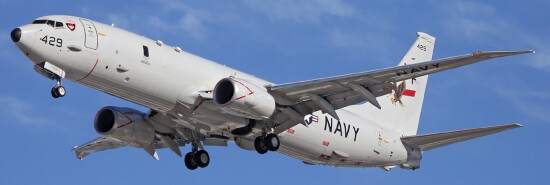
Looking for a new Lada, or why a US submarine hunter might be flying over the Baltic Sea
Tom Rogan
Flight radar websites show that a U.S. Navy submarine-hunting aircraft flew from either the U.S. or Scotland to the Baltic Sea on Tuesday. As of Tuesday afternoon eastern time, the P-8 Poseidon is flying circuits over the Baltic Sea.
It’s possible that the maritime surveillance aircraft is simply training or gathering intelligence on surface vessels of Russia’s Baltic Fleet. But it may be monitoring a Russian submarine that has been conducting trials in the Baltic Sea. The Kronshtadt is the first of a new version of Russia’s Lada-class diesel-electric attack submarine. Extremely quiet, Kronshtadt will operate under command of Russia’s Northern Fleet. That will likely see Kronshtadt act as a screening unit to defend Russian ballistic missile submarines in the Arctic and Barents seas from U.S. and British attack submarines attempting to track them. This cat and mouse game is the centerpiece of NATO’s nuclear deterrent strategy. It is thus a critical U.S. military priority that its forces can identify, track and, if necessary, destroy these Russian forces.
That brings us back to the P-8 Poseidon.
While excellent at tracking surface vessels, the P-8 is the world-leader at tracking underwater contacts. Dropping sonobuoys that listen for a submarine’s movement and other emanations, the P-8 is also equipped with an array of other sensors including advanced radar and infrared systems. These allow it to detect unusual fluctuations on the water’s surface, submarine periscopes, and submarine power emissions. That makes the P-8 particularly useful for tracking very quiet submarines like the Kronshtadt. And with the Kronshtadt engaged in sea trials to test out various elements of its systems, it presents a priceless intelligence gathering target. The Kronshtadt includes highly classified Russian naval developments, so if the U.S. can gain insight into how these systems work, NATO can better plan to deal with the Lada-class in the future.
DECODING VLADIMIR PUTIN’S LATEST NUCLEAR NONSENSE
Such preparation is sensible. While Russian ground and air forces are performing disastrously in Ukraine (with worse yet to come), Russian submarine forces have made major advances in recent years. These forces are now operating further away from Russian waters and sometimes in a very bold manner. While the U.S. currently retains the edge in undersea military operations, operating against the most capable Russian submarines affords valuable high-challenge/stress training for P-8 crews in anticipation of an increasingly likely conflict with China. The People’s Liberation Army-Navy is investing heavily in its own undersea forces, after all.
But whatever the P-8 is doing over the Baltic Sea, there’s one final point to note. Namely, the question as to why, yet again, it is the U.S. that must provide these military capabilities and not European powers? It’s a familiar question with an unfortunate answer.
CLICK HERE TO READ MORE FROM THE WASHINGTON EXAMINER
